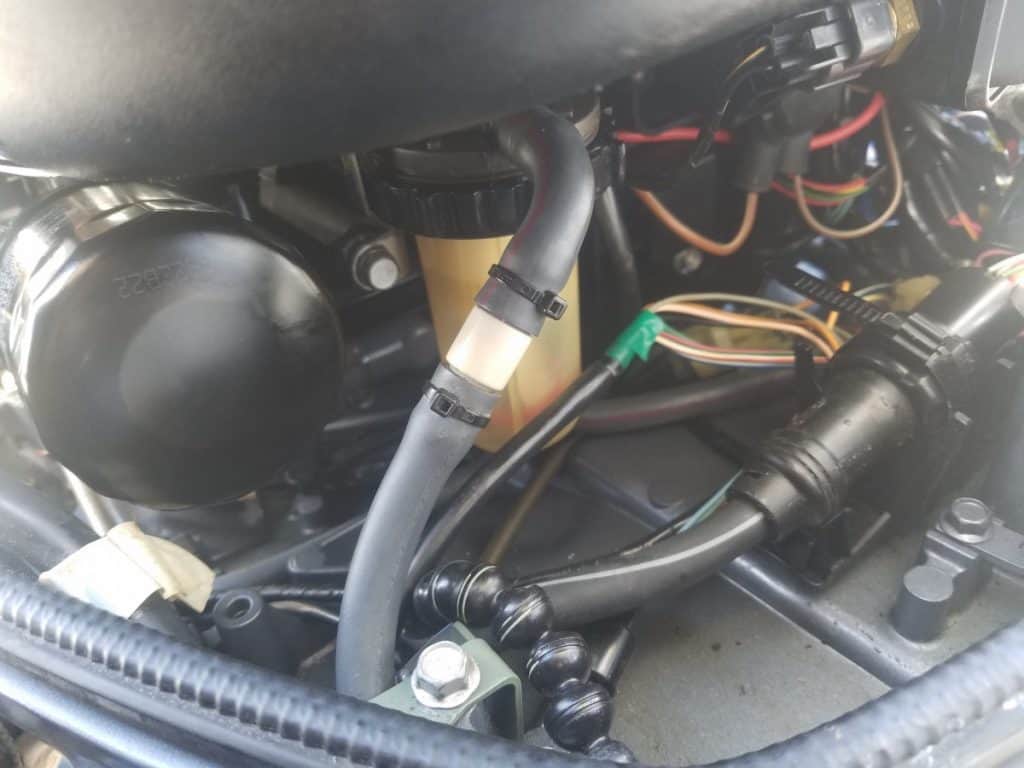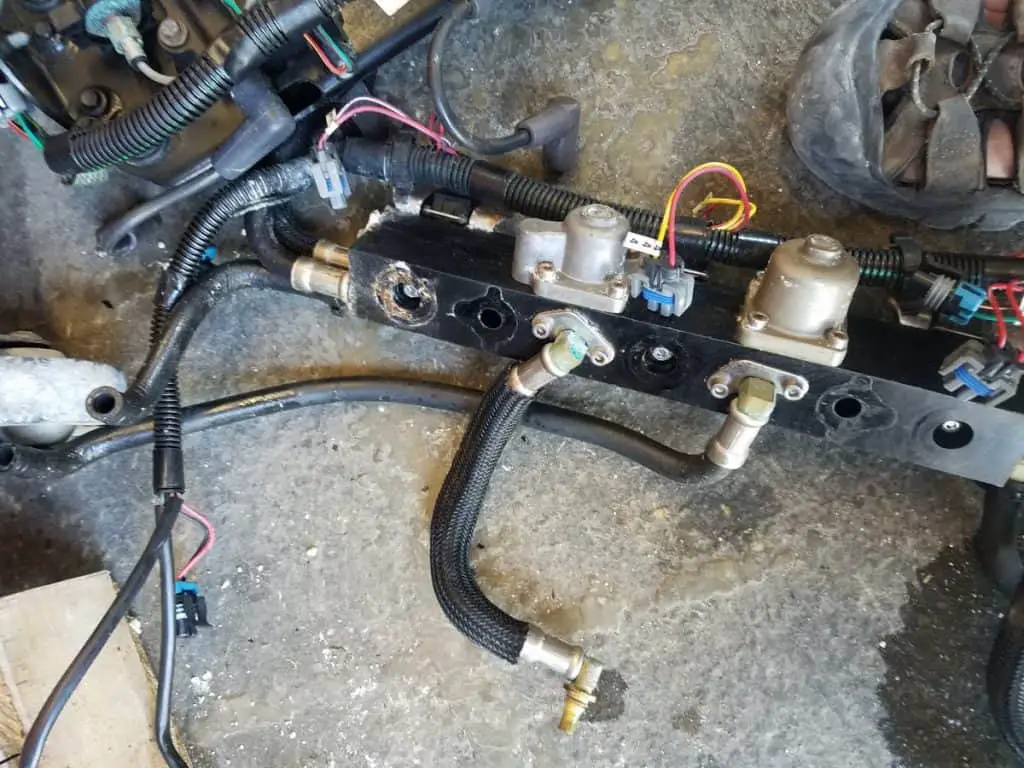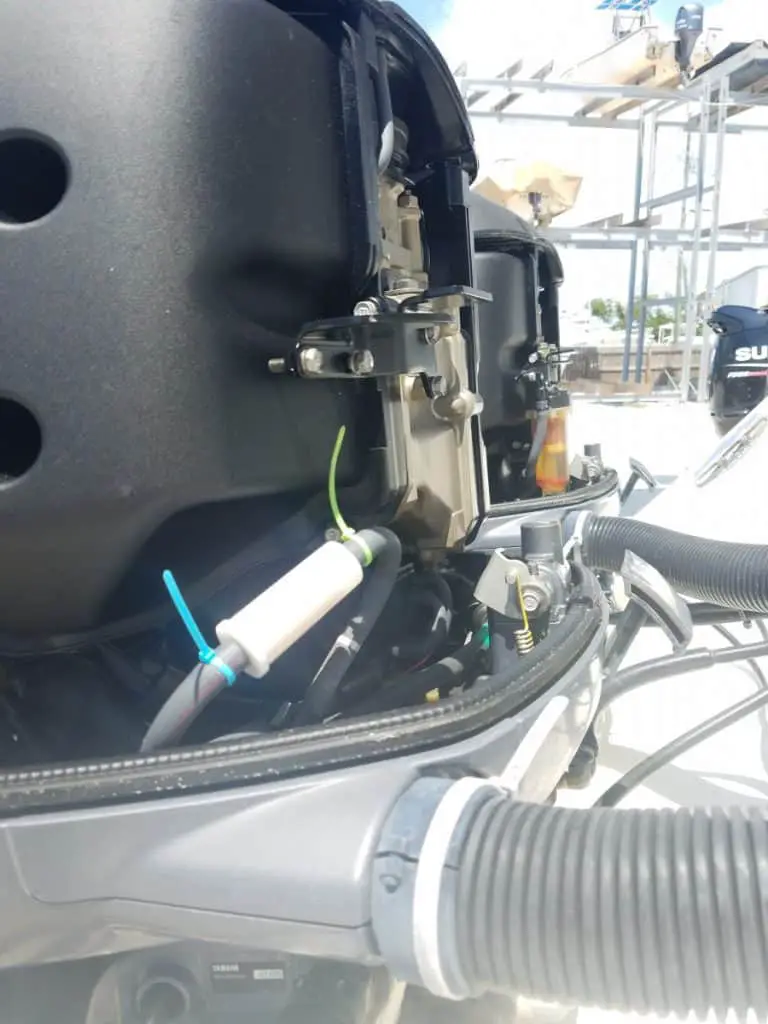What happens when you have a day planned on the water, but the outboard engine doesn’t seem to run right? If you know how to troubleshoot a bad outboard fuel pump, your day doesn’t need to be ruined.
When the outboard fuel pump is bad, it operates similarly to when the boat runs out of fuel. You might notice sputtering or misfiring before the engine cuts out completely.
To help you get back on the water, we will talk about how the outboard fuel system works, discuss ways to troubleshoot the issues and give you some expert pointers along the way.
How Does an Outboard Fuel System Work?

This pump has a sensitive diaphragm in charge or receiving the suction signal from the piston cylinder. This setup allows the pump to deliver the fuel.
The fuel pump on an outboard motor works differently than the one found in your car or truck.
When the cylinder leaks, the pump pulse signal isn’t strong enough to get the right amount of fuel to the cylinder.
Thankfully, outboard fuel pumps don’t fail often. Typically, what you think is a fuel pump issue is generally another component failing, such as a fuel pump diaphragm or bad check valve.
To understand what you are looking at, you must first know the components of the outboard fuel system.
Primary Fuel Filter
This cup filter is found on the side of the boat’s motor, sitting between the low-pressure fuel pump and the tank.
Low-Pressure Fuel Pump
This component draws fuel out of the tank and directs it to the engine.
Vapor Separator Tank
This unit holds the fuel pump and filter.
High-Pressure Fuel Pump
The VST pump pressurizes fuel before it gets to the rail.
High-Pressure Fuel Rail
This part is responsible for moving the pressurized fuel to the injectors.
VST Filter
With this filter found within the vapor separator tank, all of the fuel is filtered before it gets to the fuel pump.
Secondary Fuel Filter
The in-line filter further separates smaller contaminants from the fuel before getting to the VST.
How Do You Know When You Got a Bad Outboard Fuel Pump?

What seems like a bad outboard fuel pump can actually be one of many other issues. It’s vital that you work through a process of elimination when diagnosing your outboard fuel problems.
Often, other fuel system components are easier to troubleshoot and eliminate. However, if you want to get right to the outboard fuel pump, we have the steps you need to know.
How Do You Test a Bad Outboard Fuel Pump?
1: Turn Off Power
- Turn off the main electrical cutoff switch.
- Remove the snaps on the outboard motor upper case and take off the cowl cover.
- Take the spark plug wire boot off the plug tip. Move this wire around from the opening by taping it to another part or wedging it between components.
- With your socket wrench, remove the plug.
2: Use a Compression Gauge Hose
- Screw your compression gauge hose to the hole of the spark plug. With your hand, twist the throttle position wide open.
- With your other hand, pull the rope start, or turn the starter over to turn the engine over four or five times.
- Read the compression gauge in PSI (pounds per square inch).
- If you are troubleshooting an electric start motor, you will need a helper to crank the engine while the throttle is wide open.
3: Check Specs
- Look in your owner’s manual to find the proper PSI for your outboard engine.
- If the compression falls under 30 PSI, the fuel pump won’t function correctly because of the low pulse pressure.
- Look to fix the compression issues first.
- If the compression seems okay, you can reinstall the spark plug and perform the same test on the other cylinders.
4: Check the Sump Screen
- There must be enough fuel in the tank to be picked up. Additionally, check the sump pickup screen for clogs.
- Blow air through the tank vent, ensuring that it is flowing freely.
- You can also inspect the fuel primer bulb for leaks and cracks.
Another form of testing to see if there are fuel tank issues is to pressure test your fuel tank to find leaks, which we cover in this article here.
5: Inspect Connections & Hoses
- Examine all of the fuel connections and hoses for leaks or kinks.
- Loosen the fuel filter hose clamps and pull off the filter. You want to blow through both ends to look for obstructions.
- If the filter is good, reinstall it and tighten the clamps back up with your screwdriver.
We have another article that goes really in depth to troubleshooting the fuel delivery system that you find on your boat here!
6: Check the Pulse Hose
- Loosen the clamp on the pulse hose, which is connected to the intake manifold and fuel pump.
- Make sure you have a container underneath the hose as fuel will discharge.
- With an electric start, you will need a helper to crank the engine several times. Make sure your ignition cutoff is activated and the plug wire is removed.
- If there is a lack of fuel discharge, you might have a bad diaphragm or fuel pump check valve.
- Connect your fuel pressure gauge to the pulse hose. Crank the engine.
- Normal fuel pumps will put out between five and seven PSI. Readings below this point to a bad diaphragm or pump check valve.
- You can either replace the fuel pump or opt for a rebuild kit instead.
How Do I Know if My Fuel Pump Diaphragm is Bad?
If your outboard motor has a mechanical fuel pump. Which is what we have covered for most of this article. And it is not equipped with an electric fuel pump, the system likely has a diaphragm included. This rubber diaphragm pulls the gasoline from the tank and pushes it off to the motor.
When the diaphragm wears out or becomes damaged, the mechanical fuel pump might not work at all or cause performance issues.
Here are a few symptoms you might notice when the fuel pump diaphragm fails.
Leaking
If the diaphragm becomes worn or torn, fuel can escape through the diaphragm and come out of the fuel pump housing. Eventually, these will fail completely, causing the engine to stop running.
Stalling
As the fuel pump produces less pressure, the engine fails to operate. You might notice engine stalling or sputtering.
Engine Doesn’t Start
When the diaphragm is completely damaged, it will become unable to pump fuel at all. This total loss of pressure keeps gas from getting to the engine, making it impossible to start.
Fuel Bubbles In The Water
On some designs. The fuel pump is driven from the pulses of the crankcase or from a rod that is driven by the crankshaft. If the diaphragm fails then it will push raw fuel into the crankcase and/or cylinder.
Allowing the raw fuel to make its way out the exhaust and straight into the water. Then since the fuel is lighter than the water. It will float to the top of the water creating a sheen on the water and you can see bubbles of fuel floating up to the top of the water
Letting you know that the fuel pump diaphragm is bad!
Why is My Outboard Hard Starting?

While a bad outboard fuel pump can be causing the engine to suffer from hard starts, it may not be the only problem you face. For any gas-powered motor to run correctly, three things are needed:
- Fuel
- Air
- Spark that ignites the air/fuel mixture
If one of these elements isn’t supplied, the engine isn’t going to start.
Most problems are going to be related to one of these three issues. Here are some of the most common reasons the outboard is struggling to start.
Clogged Flame Arrestor
By stopping flames from contacting other fuel sources, fire is averted. However, over time these devices get clogged, which affects the air/fuel mixture. Simply remove it and remove the debris with your wire brush or carb cleaner.
Clogged Fuel Filter
When dirt gets trapped in the filter, the proper amount of fuel cannot pass through, which prevents the engine from starting.
Faulty Spark Plug
If the spark plug is fouled, it can no longer ignite the air/fuel mixture.
Dead Battery
Running down the battery can also negatively affect the power needed to start the engine.
Bad Gas
Ethanol fuels shouldn’t be kept in the tank for more than thirty days. If you are having trouble starting the engine, put fresh fuel in the tank and try again.
If you only have ethanol available to run in your boat. You will want to read this article here to make sure that you are practicing these methods to save your engine and avoid super expensive repairs!
Is It Bad to Run an Outboard Engine at Full Throttle?
You want to run your outboard motor at its peak efficiency. Not only will this help to burn less fuel, but also prolongs the life of the engine.
To determine the best speed for your boat, you want to listen to the sound of the engine. When you hit that sweet spot, the engine vibrates less and quiets down.
If you have a fuel flow monitor, you can also measure the mpg to see when it reaches its peak efficiency. However, you can’t judge simply based on this fact, as slow speeds will naturally improve fuel economy, but also cause the motor to run longer, putting more age on the engine.
Is it wrong to run the engine at wide-open throttle? Not at all!
In fact, modern outboard engines are designed to handle this. Go ahead and enjoy your boat occasionally.
And if you are worried about fuel economy, we can teach you all the tricks you need to know to improve your boat’s fuel economy here:
As well as all the tricks that you need to know about in order to get more hours out of your outboard!
Signs of a Bad Fuel Filter or Gasoline in an Outboard
Once you have ruled out the fuel pump, it’s time to look at some other options. Commonly operators use bad gas or have a failing fuel filter.
What is bad gas? It could be that you put gas into the tank that is tainted, or it might have gone bad while in the motor or fuel tank from sitting for too long.
Water and trash can get into the fuel supply, causing a clog to occur. Additionally, when fuel sits in the tank for too long, it loses octane and starts to separate or gum up the system.
The other common complaint is a fuel filter clog. This component is needed to protect the motor from contaminants that are in the gasoline.
However, just like your automotive filter, it can clog up over time. When this occurs, the fuel can’t pass through freely and a lack of pressure causes trouble.
Outboard Fuel Line Problems
Finally, if you are struggling to get your outboard running correctly, you might consider looking at the fuel lines. Blocked fuel lines keep gas from getting to the engine.
Most of the blockages start out partially. In these cases, simply pumping the primer bulb or playing with the hose will start the motor.
However, blockages aren’t going to repair themselves. Eventually, these tactics won’t work any longer.
To prevent outboard fuel line troubles, consider these tips:
- Ethanol fuel leads to more problems, but there’s no guarantee that using ethanol-free gas will solve the clogs.
- Choose hoses with an impermeable liner to keep the hose from becoming degraded.
- Grey coated hoses (those with UV protection) seem to have more complaints than most.
- Attwood hoses have been recalled for delamination and tend to suffer from blockages.
- OEM hoses will often last the longest.
It’s always wise to keep some spare hose clamps and hose on board, just in case you need a quick replacement.
Prevent a Bad Outboard Fuel Pump & Other Issues
Dealing with mechanical troubles is the worst, especially when you are ready to hit the water. To avoid headaches, it’s best to prevent a failure from occurring in the first place.
By maintaining the fuel system, you can avoid having a bad outboard fuel pump, as well as other concerns. Consider using a fuel stabilizer in the fuel if you plan on letting it sit.
Before storing it for the winter, run the stabilizer through the tank for a few minutes.
Additionally, as part of your boat maintenance, you want to replace the fuel filter once a year. You can find it under the engine’s main cover.
As with anything, if you provide a little TLC throughout the year, you have a better chance of avoiding costly problems in the future.
Check Us Out!
Check out our YouTube channel for more step-by-step guides and practical tips.
Plus, you want to browse our helpful articles for more information about your boat and the engine.
